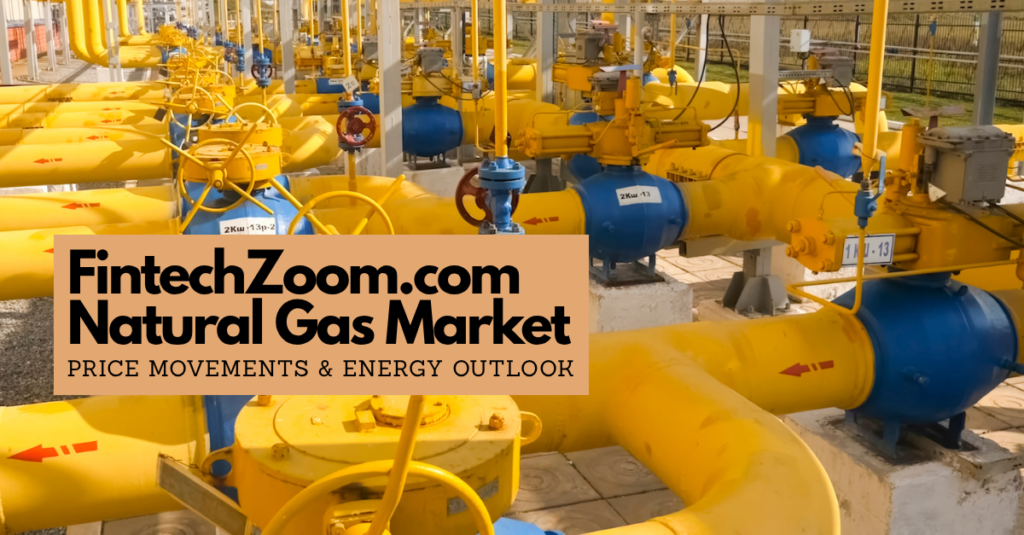Natural gas is one of the most important energy sources in the modern world. It powers industries, heats homes, generates electricity, and even fuels vehicles in some regions. As global energy demand continues to rise, understanding how the natural gas market operates has become essential for investors, traders, and anyone following economic trends.
- What Is Natural Gas?
- How Natural Gas Prices Are Determined
- Types of Natural Gas Contracts
- Historical Trends in Natural Gas Prices
- Factors Driving Natural Gas Demand
- Impact of Geopolitics on Natural Gas Prices
- Natural Gas and Renewable Energy
- Investing in Natural Gas
- How FintechZoom.com Supports Investors
- Factors to Watch in 2025 and Beyond
- Tips for Beginner Investors
- Conclusion
- FAQs
Through fintechzoom.com natural gas, users can access real-time updates on prices, in-depth market analysis, and reliable forecasts. The platform helps both beginners and professionals make informed decisions by simplifying complex data and highlighting key movements in the energy sector.
What Is Natural Gas?

Natural gas is a fossil fuel composed primarily of methane (CH₄). It forms over millions of years from the decomposition of organic matter beneath the earth’s surface. Unlike oil or coal, natural gas burns cleaner and produces less carbon dioxide, making it a preferred energy source in many countries.
It is used in several ways:
- Electricity Generation: Power plants burn natural gas to produce electricity.
- Heating: Many homes use natural gas for cooking and heating.
- Industrial Use: Factories and plants use it as a fuel or raw material.
- Transportation: Compressed natural gas (CNG) is an alternative to gasoline or diesel.
FintechZoom.com highlights natural gas as both an essential energy commodity and a financial asset with strong trading potential.
How Natural Gas Prices Are Determined

Natural gas prices fluctuate based on supply, demand, and market conditions. Several key factors influence these prices:
1. Supply and Production Levels
The amount of natural gas extracted from the ground impacts its market price. Countries like the U.S., Russia, and Qatar are major producers. When production is high and storage levels are sufficient, prices tend to drop. When production declines or supply disruptions occur, prices rise.
2. Weather and Seasonal Demand
Natural gas demand rises in winter for heating and in summer in regions where it fuels electricity for cooling. Cold winters or heatwaves often push prices higher due to increased consumption.
3. Storage and Inventories
Natural gas is often stored in large underground facilities. High storage levels can suppress prices, while low inventories can lead to spikes. FintechZoom.com tracks storage reports weekly to monitor market trends.
4. Global Energy Markets
Natural gas competes with other energy sources such as coal, oil, and renewable energy. Changes in oil prices, government energy policies, or shifts toward renewables can affect natural gas prices.
5. Geopolitical Factors
Conflicts, sanctions, or political instability in major producing regions can disrupt supply chains, causing prices to fluctuate rapidly. FintechZoom.com regularly analyzes these global risks to provide actionable insights for traders and investors.
Types of Natural Gas Contracts

Investors can participate in natural gas markets in several ways:
- Spot Market: Buying or selling natural gas for immediate delivery. Prices are influenced by current supply and demand.
- Futures Contracts: Agreements to buy or sell natural gas at a set price on a future date. Popular on exchanges like NYMEX.
- Options: Contracts that give the right, but not the obligation, to buy or sell natural gas at a predetermined price.
- ETFs and Funds: Exchange-traded funds or mutual funds provide indirect exposure to natural gas prices without holding the commodity physically.
FintechZoom.com provides detailed guides on each investment method, helping beginners understand risk and potential returns.
Historical Trends in Natural Gas Prices

Understanding past trends helps investors anticipate future movements. Some historical highlights include:
- 2000s: Prices were volatile due to hurricanes affecting Gulf of Mexico production and increased global demand.
- 2008: Natural gas prices peaked near $13 per MMBtu (Million British Thermal Units) due to high demand and supply constraints.
- 2010s: Prices dropped significantly in the U.S. thanks to the shale gas revolution, which increased supply.
- 2020: The COVID-19 pandemic led to temporary demand reductions, causing price declines.
- 2021-2023: Prices surged due to post-pandemic economic recovery, global energy shortages, and geopolitical tensions in Europe and Asia.
FintechZoom.com tracks both historical data and real-time market movements, providing charts and analysis for traders.
Factors Driving Natural Gas Demand

Global demand for natural gas is influenced by several key sectors:
1. Residential and Commercial
Heating, cooking, and cooling needs drive significant consumption in households and businesses.
2. Industrial
Industries like chemicals, fertilizers, and manufacturing require natural gas as a raw material and fuel source.
3. Electricity Generation
Natural gas power plants are favored for their efficiency and lower emissions compared to coal.
4. Transportation
Compressed natural gas (CNG) and liquefied natural gas (LNG) are growing in use for vehicles and shipping.
5. Global Energy Transition
Countries are shifting from coal to cleaner energy sources, boosting natural gas consumption in many regions.
Impact of Geopolitics on Natural Gas Prices
Global politics plays a huge role in energy markets. Conflicts, sanctions, or disputes between major producers and consumers can disrupt supply. For example:
- Sanctions on Russia have affected European gas imports.
- Political instability in the Middle East can affect LNG shipments.
- Trade agreements or export restrictions can influence global availability.
FintechZoom.com provides expert analysis on how these geopolitical factors impact prices and investor decisions.
Natural Gas and Renewable Energy

The energy transition toward renewables has a mixed impact on natural gas:
- Positive: Natural gas complements renewable energy as a backup source, especially when solar or wind is unavailable.
- Negative: Long-term goals of reducing fossil fuel consumption could decrease natural gas demand.
Investors must balance the short-term benefits with long-term energy policy trends. FintechZoom.com reports regularly on this evolving market.
Investing in Natural Gas

Natural gas investment offers opportunities but comes with risks:
- Volatility: Prices can change rapidly due to weather, supply, or geopolitical events.
- Leverage: Futures and options provide high returns but increase exposure to losses.
- Diversification: Including natural gas in a portfolio can hedge against inflation and energy price shocks.
Beginners can start with ETFs or mutual funds linked to natural gas prices for safer exposure. Advanced investors may explore futures contracts or direct trading.
How FintechZoom.com Supports Investors

FintechZoom.com stands at the intersection of finance and technology, transforming the way investors understand and act in global commodity markets. Through cutting-edge fintech tools and real-time intelligence, it empowers users to make informed decisions with confidence.
Here’s how FintechZoom.com enhances the investor experience:
- Live Price Tracking: Advanced fintech algorithms deliver real-time updates on global natural gas prices, ensuring investors always have the latest data at their fingertips.
- Market Analysis: Fintech-driven insights and expert reports decode complex market trends, offering clear guidance on price movements and future expectations.
- Historical Data Tools: Interactive data visualizations help investors analyze long-term patterns and correlations, making it easier to forecast potential opportunities.
- Trading Strategies: FintechZoom.com provides beginner-friendly guides and smart tools for creating low-risk, well-informed investment plans.
- Global News Integration: AI-powered news tracking covers economic, political, and environmental developments that influence supply and demand.
By merging financial intelligence with innovative technology, FintechZoom.com delivers a complete ecosystem for investors—turning complex market data into actionable insights and simplifying decision-making in today’s fast-paced digital economy.
Factors to Watch in 2025 and Beyond

Several trends could shape natural gas markets in the coming years:
- Energy Transition: Increasing renewable adoption could reduce long-term fossil fuel demand.
- LNG Expansion: Export of liquefied natural gas from the U.S., Qatar, and Australia will influence global pricing.
- Weather Patterns: Climate events like hurricanes or cold winters will affect seasonal pricing.
- Economic Recovery: Industrial growth and urban development will drive global demand.
- Government Policy: Regulations on emissions, subsidies for renewables, or trade restrictions will directly impact natural gas prices.
FintechZoom.com continuously monitors these factors to provide actionable insights for investors.
Tips for Beginner Investors

- Start Small: Invest modestly to understand market behavior.
- Stay Informed: Follow FintechZoom.com for updates on prices, trends, and news.
- Diversify: Include natural gas as part of a broader investment portfolio.
- Understand Risk: Prices are volatile, so be prepared for fluctuations.
- Use Reliable Platforms: Trade through reputable exchanges or funds to avoid fraud.
Conclusion
Natural gas remains a critical energy resource and an important commodity for investors. Its prices are influenced by supply and demand, weather, geopolitical events, and global energy policies. Understanding these factors is crucial for anyone looking to invest in or trade natural gas.
FintechZoom.com provides the tools, analysis, and real-time data necessary to make informed decisions in this dynamic market. From live price updates to expert forecasts, FintechZoom.com empowers beginners and professionals to navigate the complexities of natural gas trading and investment with confidence.
In a world where energy demand continues to rise and geopolitical tensions remain a factor, natural gas offers both opportunity and risk. Being informed is the best way to capitalize on these opportunities while managing exposure to volatility.
FAQs
Q: What drives natural gas prices?
A: Prices are influenced by supply, demand, weather, storage levels, global politics, and energy policy.
Q: Can natural gas be a good investment for beginners?
A: Yes, especially through ETFs or mutual funds, which reduce direct market exposure.
Q: How do seasonal changes affect natural gas prices?
A: Cold winters increase heating demand, while hot summers can boost electricity generation demand, both raising prices.
Q: Does geopolitical tension affect natural gas?
A: Yes, conflicts, sanctions, and export restrictions can disrupt supply and increase prices.
Q: What’s the difference between spot and futures contracts?
A: Spot contracts are for immediate delivery, while futures contracts are agreements to buy or sell at a set price on a future date.
Q: How can I track natural gas prices in real time?
A: FintechZoom.com provides live price charts, market news, and analysis for real-time tracking.
Q: Will renewable energy reduce natural gas demand?
A: In the long term, yes. But in the short term, natural gas complements renewable energy as a backup source.
Q: What factors should investors watch in 2025?
A: Energy transition policies, LNG expansion, economic recovery, weather patterns, and government regulations.




